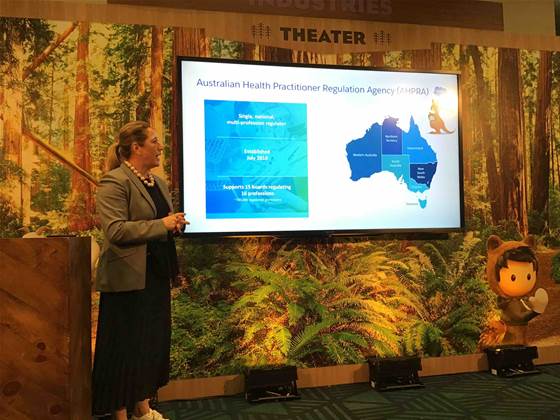Digital workflows

Future registration lodgments will be backed by an “end-to-end process” that guides applicants to the next set of questions depending on their prior answers.
The system can handle user-uploaded documents and can verify provided information at its source.
“So instead of rocking up to our reception with your passport and us thinking we know what a fake passport looks like, you type your passport number in the system and it will verify it’s authentic,” Horsfall said.
“That will save us a whole lot of information we don’t need to collect.”
There are ‘save’ and ‘resume’ functions built into the digital process, allowing applicants to enter details when they can, rather than in one hit.
Once a form is completed, “it workflows itself into our case management system” where staff can view it and monitor its progress.
“We’re able to see where an application is up to at any point in time,” Horsfall said.
“We do things like criminal history checks which take time to go out and come back.
“There’s no point in registration officers worrying about that. They need to then work through the other types of registration information to assess whether or not the application is acceptable for registration.
“Now, once the criminal history check comes back in, it flips into their inbox in Salesforce and they know they have the last piece and can finalise the application.”
AHPRA is also able to better deal with staff on annual leave or sick leave, since responsibility for applications can be easily re-assigned and the history goes with that reassignment.
Go-live for practitioners
AHPRA built a large number of proof-of-concepts to help its various stakeholders see what change would look like.
“One big learning point for us is PoCs are gold,” Horsfall said.
“A lot of people can’t visualise what it will look like but if you build a PoC you can tell them roughly what it looks like then they’re sold. The only problem then is they want the PoC in production as soon as possible.”
AHPRA tested the new digital process and system on graduates as they tried to register to work in health for the first time in October 2017.
“It probably wasn’t the best way to test it because [while] they loved it, the next day they were asking ‘well why aren’t I registered?’, because [after lodgement] it hits a manual process and then you have to go through a process that takes a couple of months so they weren’t very happy [about that part],” Horsfall said.
However, with the first test completed, it has now moved on to apply the digital platform to other registered health professionals.
The most recent go-live on September 3 was for paramedics. This does not replace a previous registration system as it is the first time that paramedics have ever been registered in Australia.
“There’s 16,000 of them and the uptake on the paramedic registration process has been phenomenal,” Horsfall said.
“We’ve got over 4,000 applications already in the system, and then the experience they’ve had is it’s 20 minutes to fill their application form, pay their money, and they’re done. That has been great feedback for us that we’re on the right track.”
Tokenised future
Horsfall envisions a future-state where every health practitioner in Australia has their own “digital token”.
The token would not only house their updated registration details but also show AHPRA where they work at any particular point in time.
It would also have the capability of sharing with hospitals, clinics and other employers the real-time status of that practitioner’s registration.
“To have that tokenised view and real time view is so important because we could be putting someone in [a hospital] who may have been OK yesterday but today has changed,” she said.
“It’s now about how we make that real time and build it into the ecosystem of health.”
Horsfall suggested a token could also contain facial recognition attributes to make it easier to authenticate practitioners throughout the health system.
She suggested tokens would also be useful to practitioners, saying that it would be important to create an ecosystem of potential use cases around them.
“I want to create something for health practitioners that makes them want to come back to us every day,” Horsfall said.
“It should contain more than just their registration. It should contain information that might interest them about their profession, or they might have cubes of data about their research if they have a research bent.
“It’s trying to draw them in so they’re information isn’t out of date.”
Ry Crozier is attending Dreamforce 18 in San Francisco as a guest of Salesforce.


.png&h=140&w=231&c=1&s=0)

_(20).jpg&h=140&w=231&c=1&s=0)





 iTnews Executive Retreat - Security Leaders Edition
iTnews Executive Retreat - Security Leaders Edition












_(1).jpg&h=140&w=231&c=1&s=0)



